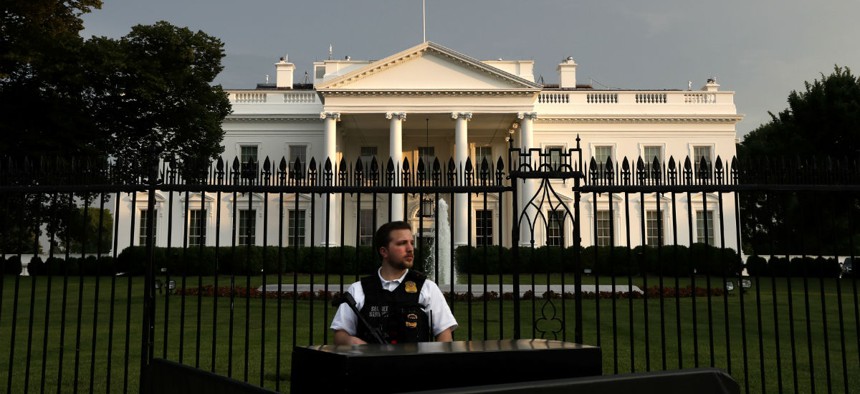
Jacquelyn Martin/AP
Secret Service Training Crimped by Rising Workload Under Trump, GAO Finds
Review of remedies following 2014 breach at White House cites some progress.
The Secret Service, tasked several years ago with upping its training regime following breaches of the White House compound by a vehicle, individuals and a drone, has made modest progress toward meeting its training targets, a watchdog concluded.
But the protective service, part of the Homeland Security Department, “lacks a documented process for collecting Uniformed Division training data that the agency can use to determine whether officers trained for [the required] 10 percent of their work hours,” said a report released last week by the Government Accountability Office. And the enhanced training is insufficiently focused on staff assigned to the president and vice president—made more challenging during the Trump administration because of frequent executive travel, GAO noted.
The review was prompted by a series of intrusions beginning on Sept. 19, 2014, when an identified man jumped the north fence and entered the White House, a threat later deemed to have arisen from a “catastrophic failure of training,” GAO explained.
A U.S. Secret Service Protective Mission Panel then made 19 recommendations for enhancing agent security skills and routine training so they are “prepared to face every evolving threat in a rapidly changing environment.”
Among the recommendations was specific training targets, and the service then agreed to 10 percent training time for most agents, but 25 percent for those assigned to the president and vice president.
The agency runs drills and training scenarios every two weeks at such places as the White House, directly outside the White House at the Treasury Building, and at the Naval Observatory near the Vice President’s home.
GAO credited the service with successfully implementing 11 of the recommendations, boosting the number of agents and officers in divisions protecting the president and White House planning a new fence around the complex.
“However, according to a senior Office of Protective Operations official, the fast operational tempo (i.e., heavy workload) hampered agents’ ability to participate in training,” auditors found. “This official told us that the amount of protection that the Secret Service provides dictates how often agents are assigned protection assignments during the training shift. Senior Secret Service officials further added that the number of protectees and the amount of travel for the current protectees is higher for the current administration than for prior administrations, which reduces the time agents have available for training.”
While agencywide training rose by 10% from 2014 to 2018, training increased comparatively less for those assigned to the president and vice president. The latter special agents “reported attending training for about 5.9% and 2.9% of their regular work hours in fiscal year 2018, respectively, compared with 3.3% and 1.9% in fiscal year 2014.” But those assigned to the president and vice president missed achieving the 25% training target by 76% and 88% each.
The service managers, in response to a draft of the GAO findings, said they no longer agree with the 25% training target and plan to reevaluate it.
GAO recommended that the service develop and implement a plan to ensure that special agents assigned to the Presidential and Vice Presidential Protective Divisions reach annual training targets, and also develop a plan for collecting full data on training hours.
Both the Secret Service and DHS officials agreed, though the service no longer backs the 25% training requirement, and said they would work with the Office of Protective Operations to arrive at a proper metric.







